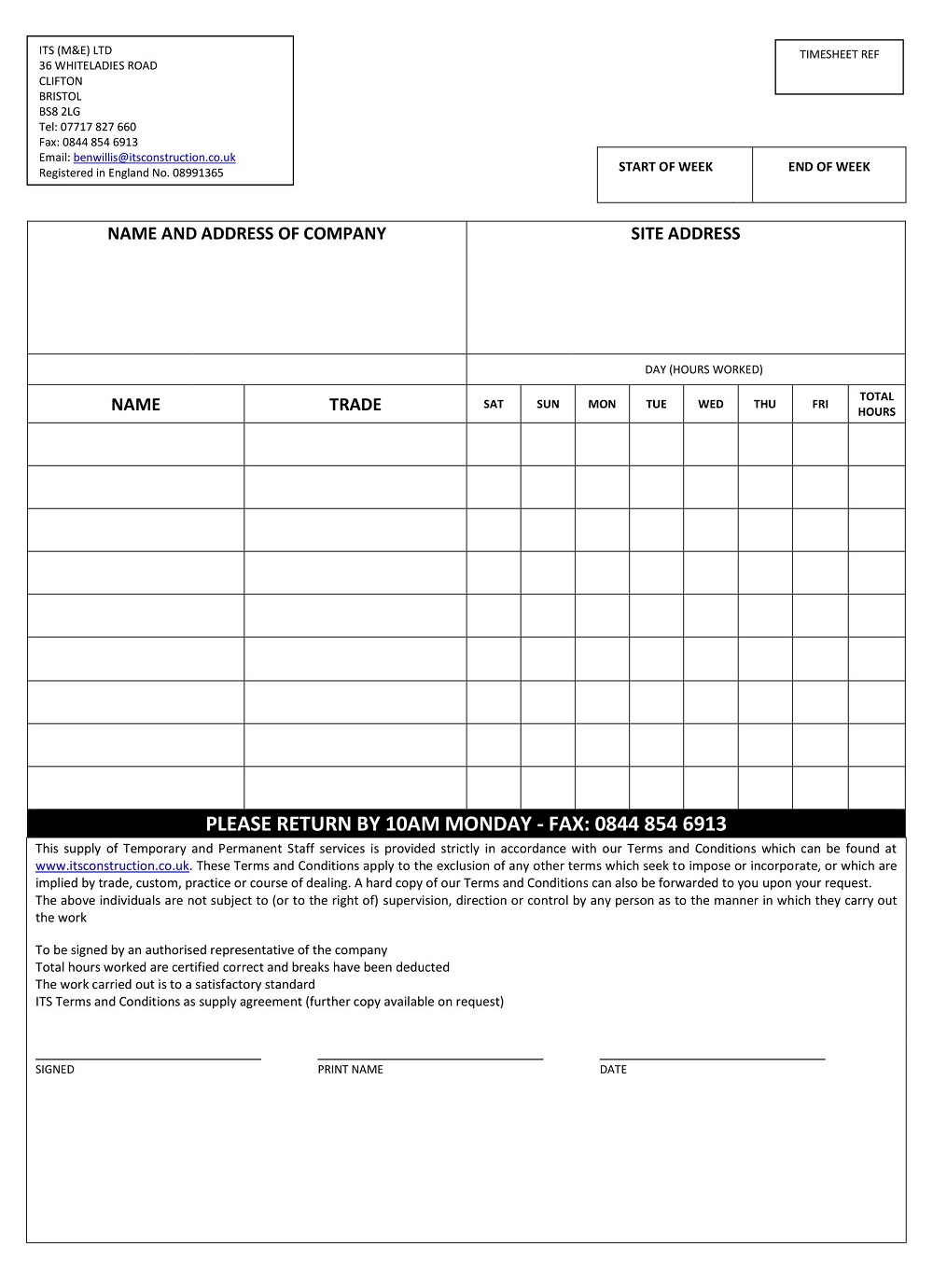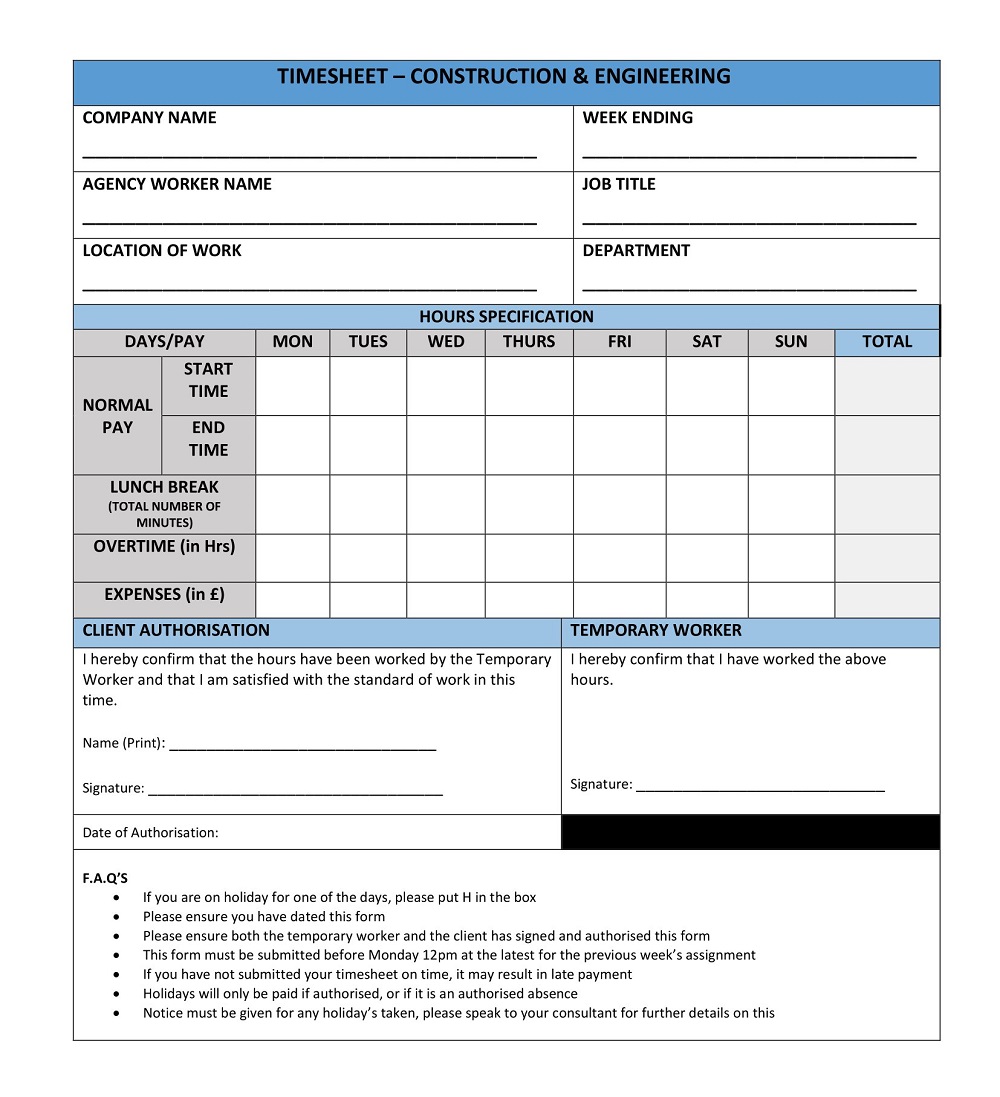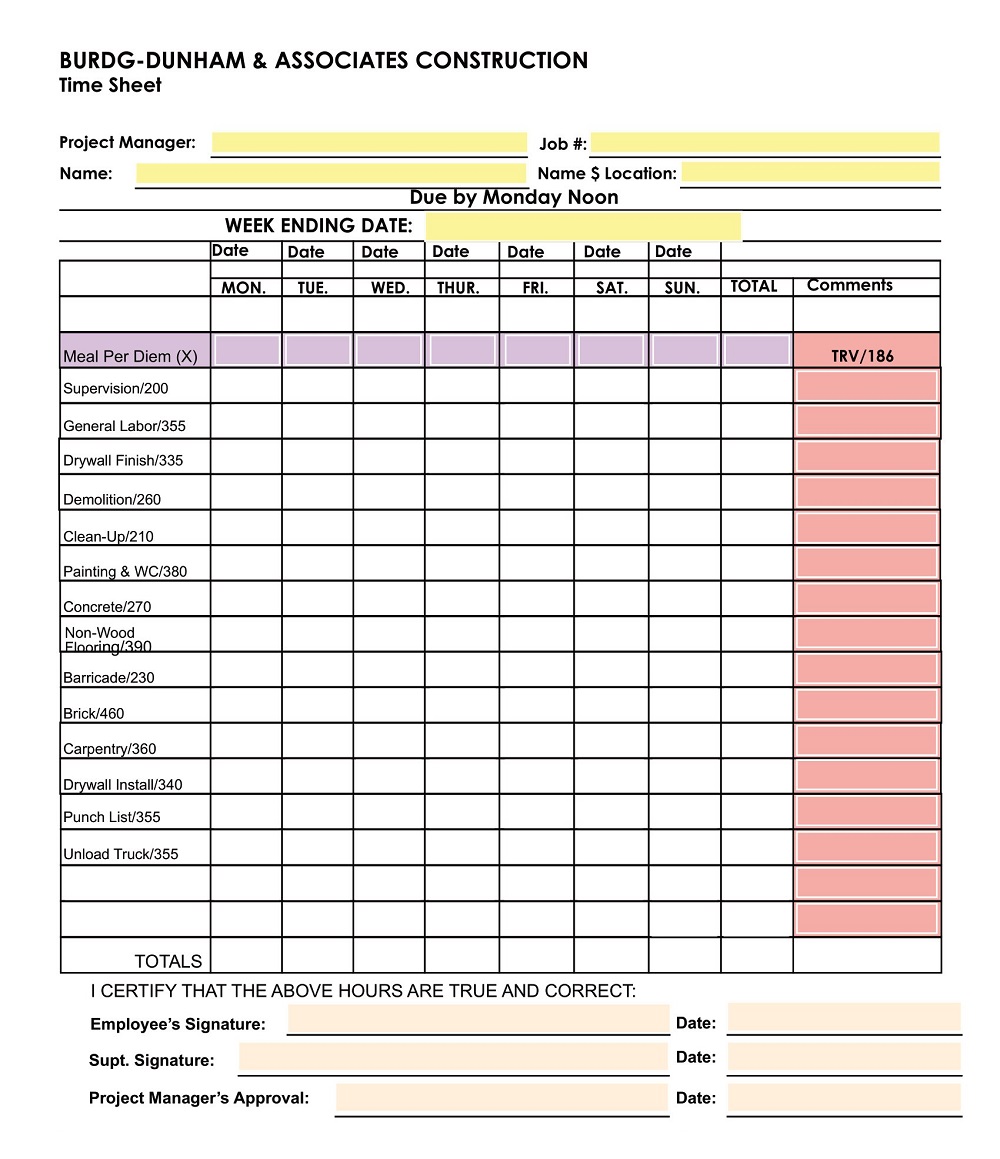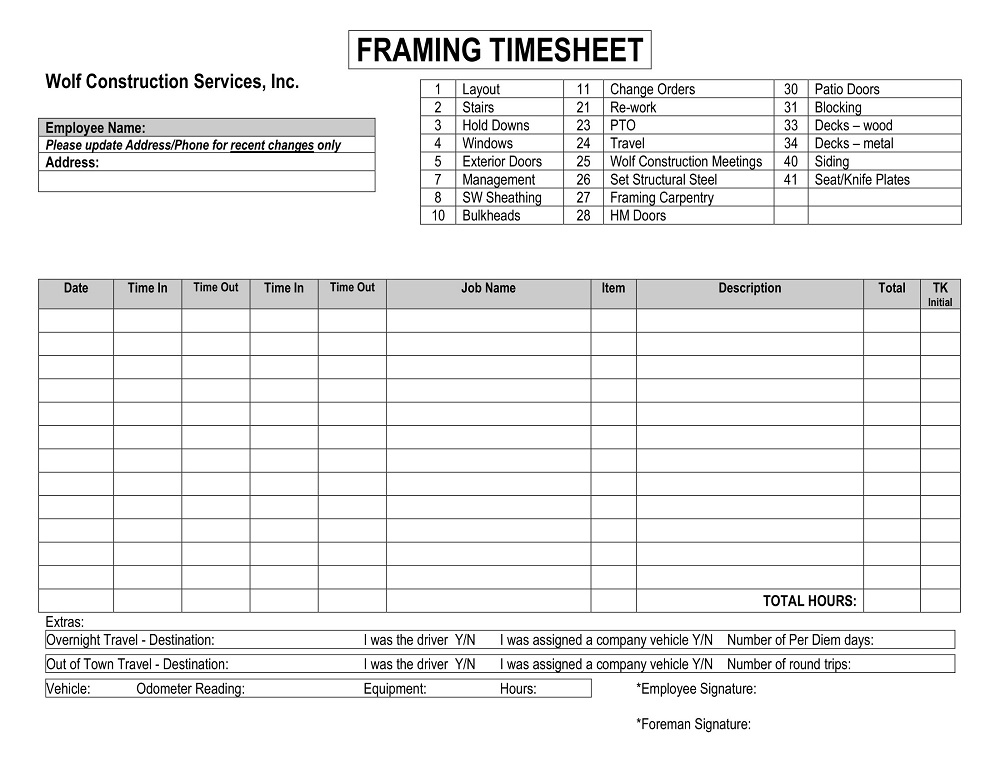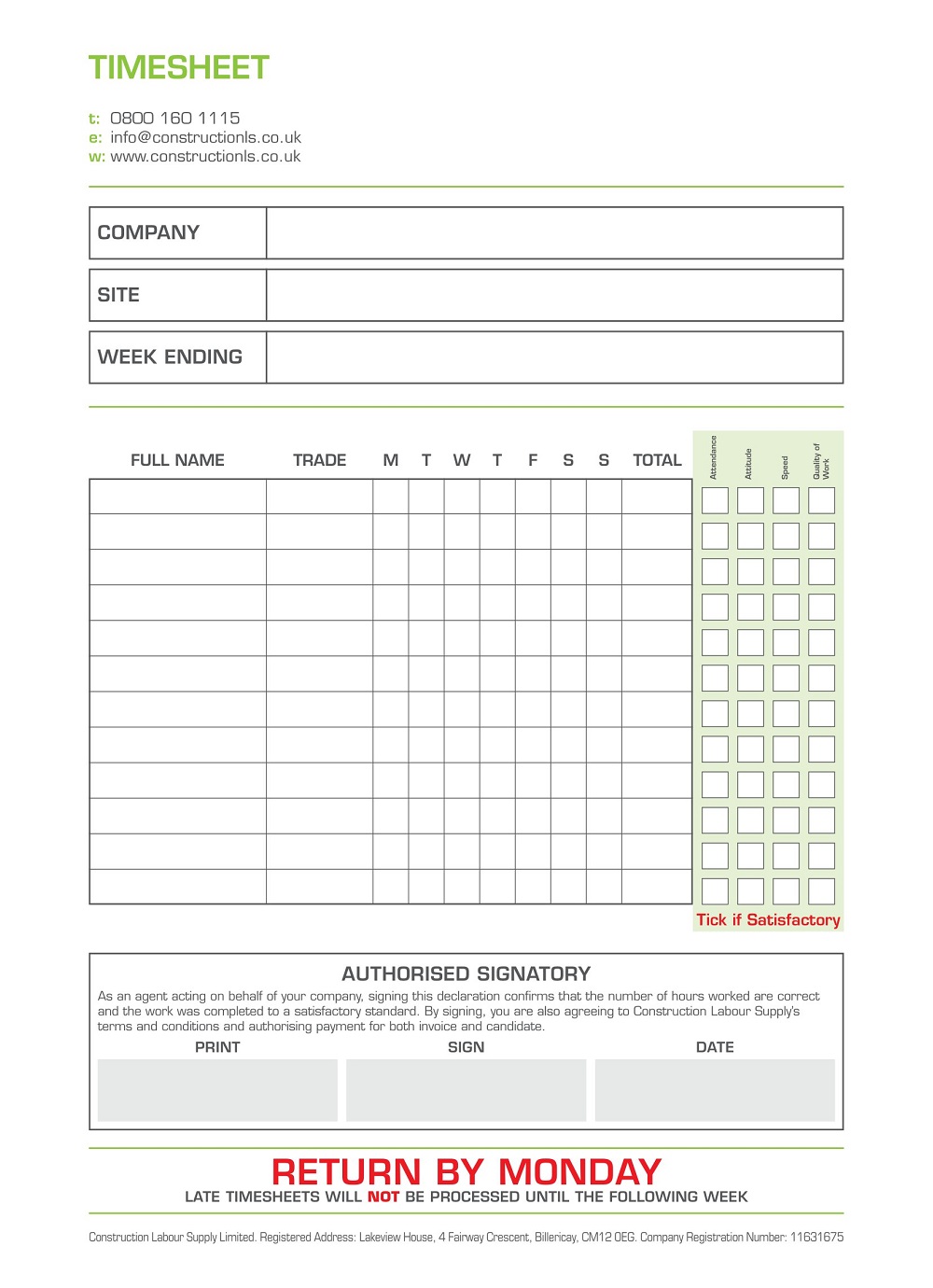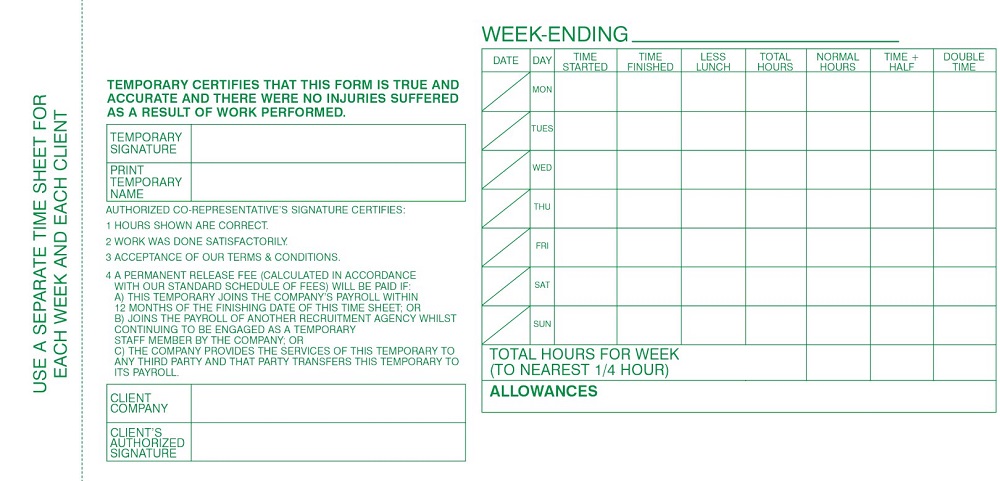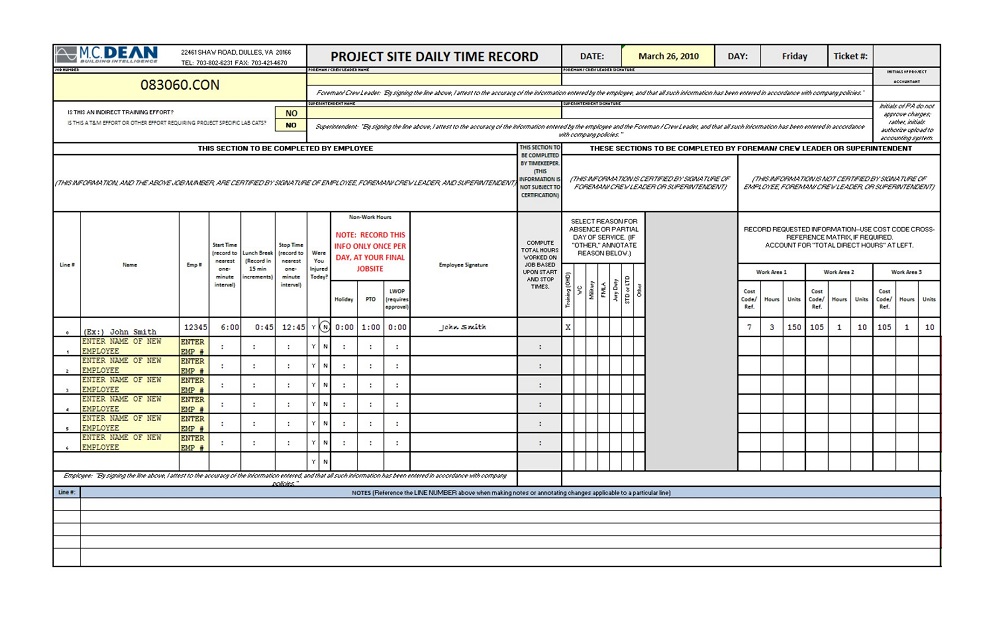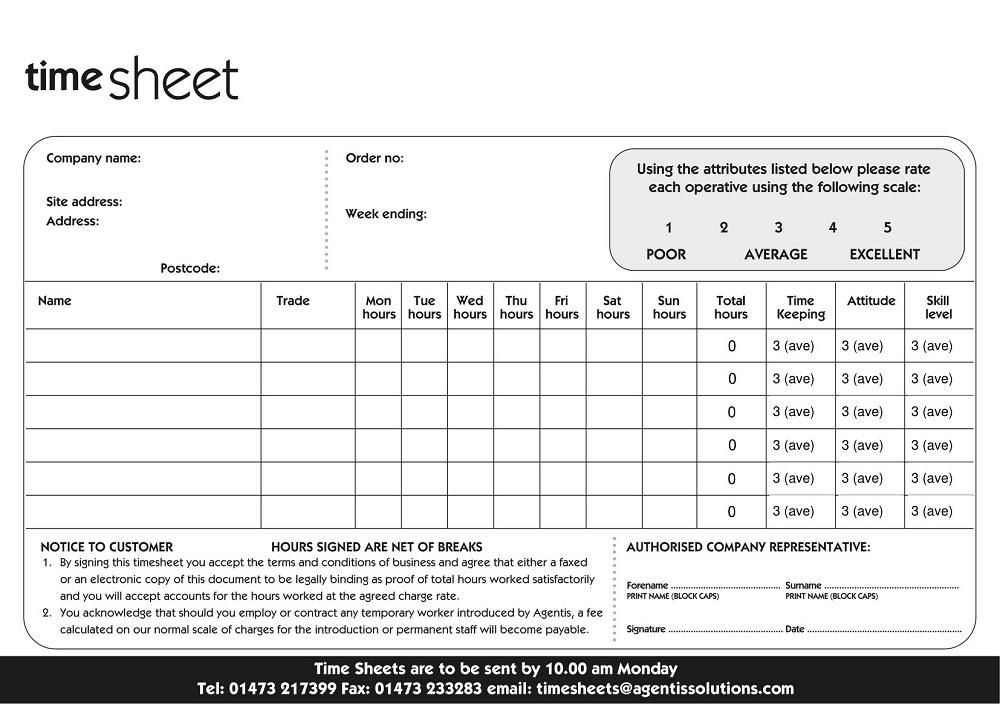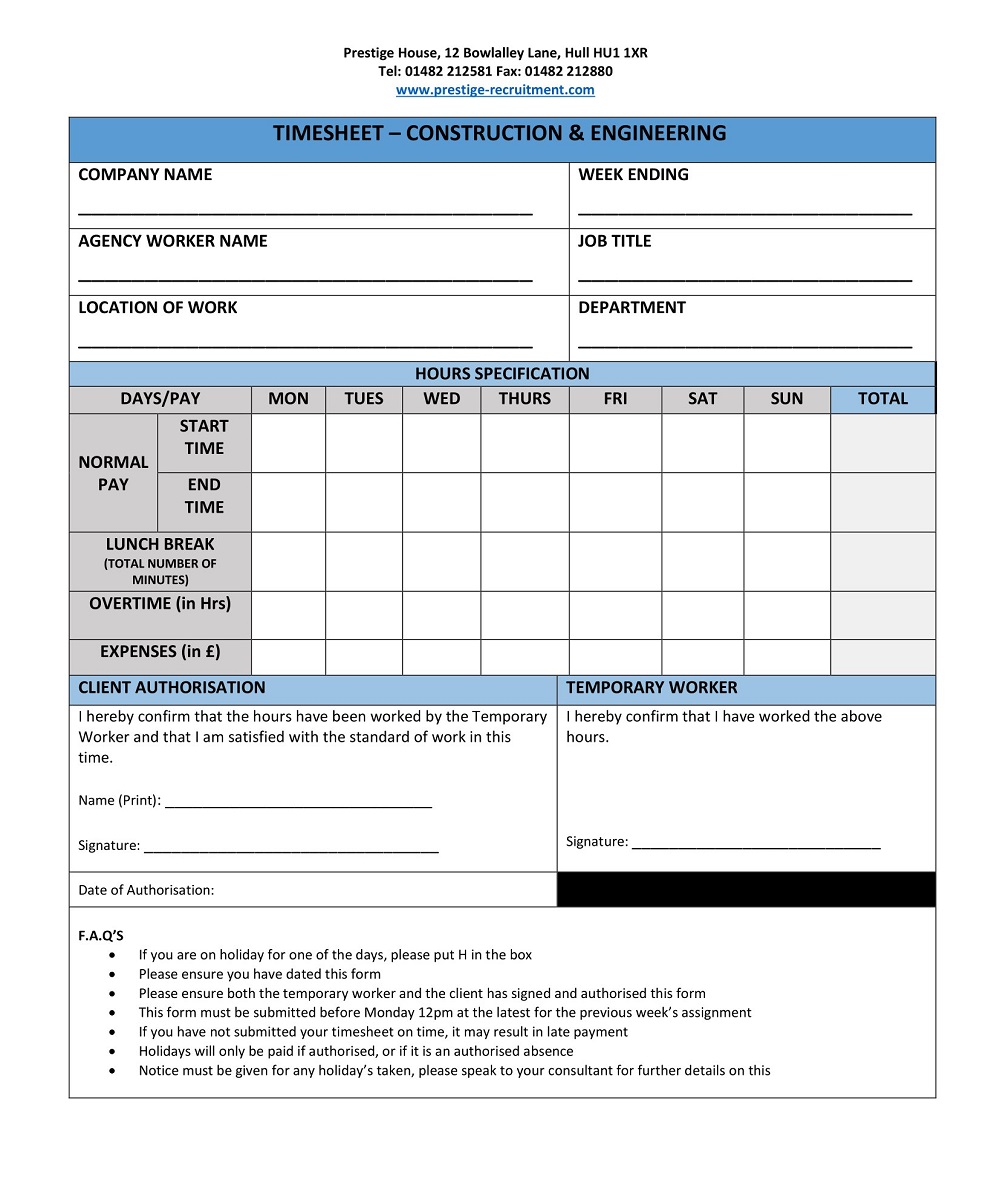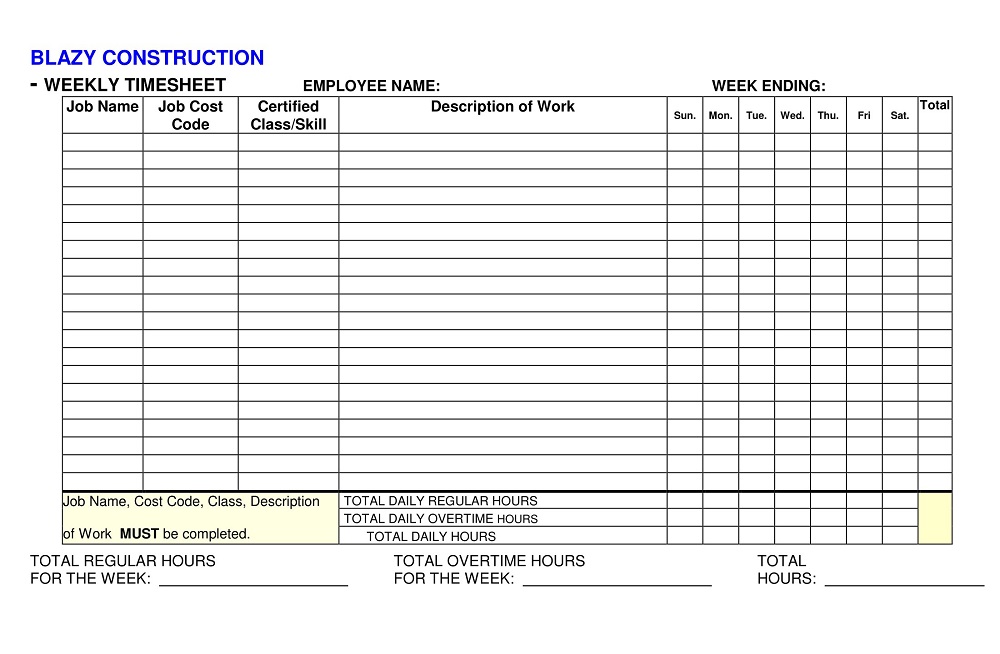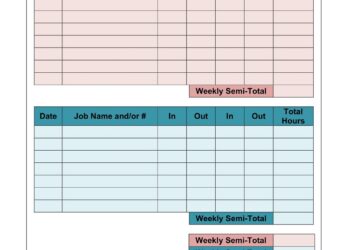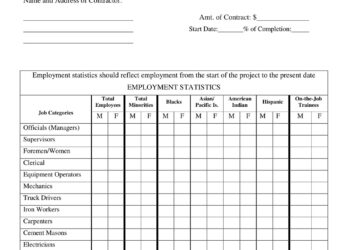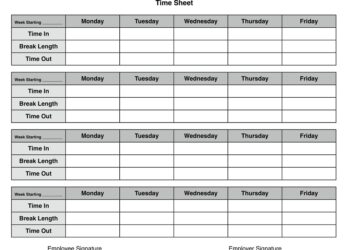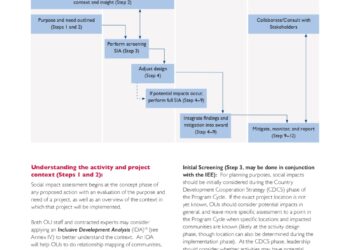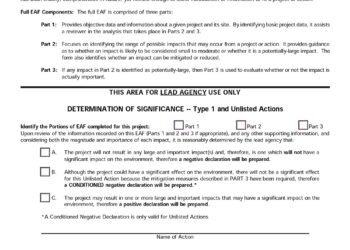A construction timesheet template is a pre-planned document or spreadsheet used by construction companies and workers to track and record the hours worked by employees or contractors on construction projects. These templates help monitor and manage labor costs, project progress, and workforce efficiency. It helps ensure accurate and transparent record keeping, which is essential for paying employees, managing project costs, and complying with labor regulations. These templates can be in a variety of formats, including paper-based forms or digital spreadsheets, making it easy for construction companies to adapt their preferred record-keeping method.
They are especially important in industries where labor costs represent a large portion of the total project cost. These templates are pre-planned documents or spreadsheets used by construction companies and workers to track and record the hours worked by employees or contractors on construction projects. These templates help monitor and manage labor costs, project progress, and workforce efficiency. In this article, you’ll find a collection of free Simple Construction Timesheet Examples and Templates in PDF, Word, and Excel format to help you make your work effective.
Download Free Editable Construction Timesheet Templates
Basic Construction Timesheet Template |
Civil Construction Labour Timesheet Template |
Construction and Enganier Timesheet |
Construction Associate Timesheet Template |
Construction Framing Timesheet Template |
Construction Multi Timesheet Sample |
Construction Personnel Time Sheet Template |
Construction Recruitment Timesheet Template |
Construction Services Timesheet Template |
Construction Timesheet Template PDF |
Construction Weekly Foreman Timesheet |
Generic Construction Timesheet Template |
Modern Construction Timesheet Template |
Printable Construction Timesheet Template |
Professional Construction Timesheet Template |
Sample Construction Timesheet |
Simple Construction Timesheet Template |
Staff Construction Time Sheet Template |
Standard Construction Timesheet Template |
Weekly Construction Timesheet Template |
Elements of Construction Timesheet Templates
A construction timesheet template is a useful tool for tracking the hours worked by construction workers and contractors on a construction project. Here are some main key elements you should include in it:
- Employee or Job Information: This includes the employee’s name, their ID or employee number, and other relevant details.
- Date and Time: Each timesheet entry must include the date and times of the start and end of the work shift.
- Project Information: Information related to the specific construction project the worker is assigned, such as project name, location, or job code.
- Tasks or Job Codes: A breakdown of the tasks or job codes associated with the work performed. This may include activities such as framing, plumbing, electrical work, etc.
- Hours Worked: The total number of hours worked by the employee in each task or throughout the day.
- Overtime and Breaks: Sections for recording any overtime hours worked and breaks taken during the shift.
- Signatures: Spaces for the employee and supervisor or manager to sign and verify the accuracy of recorded hours.
What is a Construction Timesheet?
It is a document used in the construction industry to track and record the hours worked by employees, contractors, and subcontractors on a construction project. It serves as a critical tool for project management, accounting, and compliance purposes. The main purpose of a construction timesheet is to accurately record and document the time and labor spent on various tasks and activities on a construction site.
It usually includes workers’ names, their employee or contractor identification numbers, and contact information. It records the date and the start and end times of each work shift. This information is necessary for calculating the total hours worked. They specify the project name, location, and a brief description of the tasks performed. This helps to account for the time worked on specific projects or work orders. It may have space for workers to list their tasks during a particular shift. It helps in tracking the allocation of work to various activities on the construction site.
What makes a Good Construction Timesheet?
A good construction timesheet is essential for accurate record-keeping and project management in the construction industry. It helps track the time and labor resources allocated to different tasks, which is important for billing, project cost analysis, and overall project efficiency. The timesheet should have a clear and easy-to-read format, which makes it easier for workers to record their hours. Include spaces for the date and time when work starts and ends each day. Collect the name of the employee or worker, their ID or employee number, and contact information. Provide space to specify project or job names, codes, or other identifying information.
Include a section for task or activity descriptions. Workers should be able to list the specific tasks they are working on each time they log in. If applicable, include a field for the project stage or specific location within a larger project, as this will help track progress and costs. Clearly designate fields for recording total hours worked per day, and differentiate between regular hours, overtime, and any other applicable categories. Provide a space for the employee’s signature to confirm the accuracy of the entries. In addition, include a section for the approval of a supervisor or manager. If it is used for payroll, it should include payroll information, including hourly wages or salary, and the calculation of overtime hours and rates.
Importance of Construction Timesheet Templates
A timesheet template is a valuable tool for a variety of reasons, especially in a professional or work setting. Its importance lies in its ability to help organizations, employees, and managers effectively track and manage their time. It allows employees to record the time they spend on various tasks, projects, or activities. This data is important for understanding how time is spent and can lead to more efficient time management.
For businesses that bill clients based on hours worked, timesheets are essential. They provide an accurate record of billable hours, which is essential for accurate and fair invoicing. It helps project managers track the progress of tasks and projects. This information can be used to make adjustments and ensure that projects stay on schedule. In organizations with multiple projects or clients, it helps with resource allocation. Managers can use timesheet data to determine which projects or clients are consuming the most time and adjust resources accordingly. Some industries and government contracts require detailed timekeeping to ensure compliance with labor laws and contract terms. It provides the necessary documentation.
They are a fundamental part of payroll processing. They help determine employee wages, overtime, and other compensation factors accurately. It can be used as a basis for performance evaluations. Managers can monitor how employees spend their time and make decisions about promotions, bonuses, or training requirements. It creates a valuable historical record of work activities and time spent. This information can be useful for analyzing trends and making data-driven decisions. It helps organizations identify areas where they may be spending too much time and resources. This can lead to cost savings and increased profits. It promotes transparency in the workplace. They hold employees accountable for their time and activities, explaining what was done and when. By analyzing timesheet data, organizations can identify bottlenecks, inefficiencies, and areas for improvement. This can lead to smoother processes and better productivity.
How to use the Construction Timesheet Templates?
Using a timesheet template is a straightforward way to track and record the hours worked by employees or for personal time management. Here are the general steps to use the timesheet template:
- Choose a timesheet template that suits your needs. Download the template and open it in the software application of your choice.
- There are columns and categories such as date, arrival time, departure time, total time, and possibly project or task information. Customize the template by adding your organization’s name, employee name, project name, or other relevant information. You can also adjust the format, font, and colors to suit your preferences.
- If it is for employees, enter their names, employee IDs, or other identifying information.
- For each day, enter the time and hours for each employee. These templates allow you to specify the project or task associated with those hours.
- Create a formula or use the built-in functions of your spreadsheet software to calculate the total hours worked per day. Usually, this involves reducing the time from the time.
- At the end of it, calculate the total hours worked for each employee during a week or other predetermined pay period. This may include adding up daily totals.
- If it requires approval, have employees or supervisors sign or approve it. This can be done by physically or electronically, depending on your organization’s processes.
- If the timesheet is used for payroll purposes, submit the approved timesheets to the payroll department. Whether for project management or client billing, use the data as needed for reporting or invoicing.
What are the types of Construction Timesheet Templates?
Timesheet templates come in a variety of formats to suit different needs and preferences. Here are some common types of timesheet templates:
- Weekly Timesheet: This is one of the most common types of timesheet. It allows employees to track their hours worked each week. This usually includes columns for each day of the week, with space to enter the start and end times for each day.
- Bi-Weekly Timesheet: Similar to the weekly timesheet, but covers a two-week period. It usually includes separate sections for one week and two weeks.
- Monthly Timesheet: It covers the entire month, making it suitable for salaried employees who need to record their working hours for project tracking or overtime purposes.
- Daily Timesheet: It allows employees to track their hours each day. It usually includes columns for each day of the month and details about tasks or projects being worked on.
- Project-Based Timesheet: This is designed for employees who work on multiple projects or tasks. It usually includes sections for each project, where employees can log the time spent on each project separately.
- Employee Timesheet: This is usually used by managers or HR departments to track the hours worked by employees. This may include fields for employee information, such as name, employee ID, and department.
- Contractor Timesheet: Designed for contractors or freelancers, this template helps track hours worked on various projects for multiple clients. It may also include space for billing rates and client information.
- Overtime Timesheet: An overtime timesheet is used to specifically track overtime hours worked by employees. It usually includes separate sections for regular hours and overtime hours.
- Printable Timesheet: These templates are designed to be printed and filled out by hand, making them suitable for employees who work in environments where electronic devices may not be available.
How to download the free Timesheet Template as a PDF
To download a free template as a PDF, you can follow these steps:
Select a template that fits your needs. Here are clearly offered as PDF downloads. Click on the link or button provided to download. The website asks you to enter your email or complete a short survey before allowing you to download. Be careful about sharing personal information and make sure the source is trustworthy.
If it is not in PDF format but in a different format (eg, Word or Excel), you can save it as a PDF by using a virtual PDF printer or converter. Open the template using the respective software (for example, Microsoft Word or Excel). Go to “File” and then “Save As.” Select PDF format as output and save the file. After downloading the template, review it to make sure it meets your needs. If any changes are required, you can do so using the appropriate software.
How to download the free Timesheet Template as a Word File
When you find a suitable template, click the link to view the template. Usually, you can preview the template before downloading. Look for the “Download” or “Edit in Word” option. Make sure the template is in Word format (usually .docx or .doc) to make sure you can open and edit it using Microsoft Word or a compatible word processing software.
After clicking the download button, the template will usually be saved on your computer. You can choose where to save it. Locate the downloaded file on your computer, and double-click it to open it in Microsoft Word or your preferred word processing software. Edit the template to include your specific details, such as your company name, project details, employee names, and dates. You can also format it if needed. Save the document with a new name to avoid overwriting the original template so you can use it again in the future.
Conclusion
A well-designed timesheet template is an invaluable tool for employers and employees to accurately track and manage work hours, tasks, and projects. This offers many benefits, including improved transparency, better project management, and more efficient payroll processing.
In conclusion, using a timesheet template can streamline timekeeping processes, improve accountability, and ultimately lead to more effective time and resource management in any organization. Whether it’s for a small business or a large corporation, it can play an important role in ensuring that time is spent efficiently and that employees are paid fairly for their work. By using this tool, companies can better monitor their operations, improve productivity, and maintain a healthy work-life balance for their employees.
Reference Link


